Analytical Solution for the Deformation of Pipe Galleries Adjacent to Deep Excavation
Abstract
:1. Introduction
2. Basic Solution to Elastic Plane Strain Problems
2.1. Mechanical Model for Elastic Plane Strain Problems
2.2. Method of Separation of Variables for Plane Strain Problems
3. Analytical Solution of Excavation-Induced Ground Movement
3.1. The Translation Mode of the Wall Movement
3.2. The Rotating Mode of the Wall Movement
3.3. The Triangle Mode of the Wall Movement
3.4. The Parabolic Mode of the Wall Movement
3.5. Distribution Patterns of Ground Surface Settlement under Different Wall Movement Types
4. The Excavation-Induced Settlement of the Pipe Gallery behind the Retaining Wall
4.1. Method Description
4.2. Verification of the Method by Field Measurements
5. Parametric Studies on Excavation-Induced Pipe Gallery Settlements
5.1. Distance to The Pit
5.2. The Stiffness of the Pipe Gallery
6. Conclusions
- During the extension from 2D to 3D of the proposed solution in this work, two experimental formulas of the ground settlement distribution along the longitudinal direction of retaining structures (i.e., Zhang’s formula and Finno’s formula) are used and evaluated. The comparison with field data shows that the proposed solution of this work combined with Finno’s formula provides more desirable results, while Zhang’s formula tends to provide overconservative pipe gallery deformation.
- The ground settlement behind the retaining structure follows a spoon-shape pattern, i.e., the settlement first increases with the increase in distance from the pit until its maximum value; then, the settlement gradually decreases to a negligible value. The deformation distribution of the pipe gallery is closely in accordance with the distribution of ground settlement at the corresponding location.
- From a magnitude close to the ground settlement at the corresponding position, the maximum deformation of the pipe gallery decreases with increasing stiffness.
Author Contributions
Funding
Data Availability Statement
Conflicts of Interest
References
- Wang, C.; Liang, F.; Yu, X. A review of bridge scour: Mechanism, estimation, monitoring and countermeasures. Nat. Hazards 2017, 87, 1881–1906. [Google Scholar] [CrossRef]
- Rehman, Z.; Zhang, G. Three-dimensional elasto-plastic damage model for gravelly soil-structure interface considering the shear coupling effect. Comput. Geotech. 2021, 129, 103868. [Google Scholar] [CrossRef]
- Gallikova, Z.; ur Rehman, Z. Appraisal of the hypoplastic model for the numerical prediction of high-rise building settlement in neogene clay based on real-scale monitoring data. J. Build. Eng. 2022, 50, 104452. [Google Scholar] [CrossRef]
- Rao, P.; Feng, W.; Ouyang, P.; Cui, J.; Nimbalkar, S.; Chen, Q. Formation of plasma channel under high-voltage electric pulse and simulation of rock-breaking process. Phys. Scr. 2023, 99, 015604. [Google Scholar] [CrossRef]
- Shao, W.; Qin, F.; Shi, D.; Soomro, M.A. Horizontal bearing characteristic and seismic fragility analysis of CFRP composite pipe piles subject to chloride corrosion. Comput. Geotech. 2024, 166, 105977. [Google Scholar] [CrossRef]
- Shao, W.; Li, Q.; Zhang, W.; Shi, D.; Li, H. Numerical modeling of chloride diffusion in cement-based materials considering calcium leaching and external sulfate attack. Constr. Build. Mater. 2023, 401, 132913. [Google Scholar] [CrossRef]
- Cui, J.; Jin, Y.; Jing, Y.; Lu, Y. Elastoplastic Solution of Cylindrical Cavity Expansion in Unsaturated Offshore Island Soil Considering Anisotropy. J. Mar. Sci. Eng. 2024, 12, 308. [Google Scholar] [CrossRef]
- Attewell, P.B.; Yeates, J.; Selby, A.R. Soil Movements Induced by Tunnelling and Their Effects on Pipelines and Structures; Methuen, Inc.: New York, NY, USA, 1986. [Google Scholar]
- Fang, K.; Zhang, Z.; He, J.; Liu, X. Pipelines Deformation Control for Double-Row Supported Excavation; ICPTT 2011; American Society of Civil Engineers: Reston, VA, USA, 2011; pp. 440–447. [Google Scholar]
- Jia, X.; Zhang, H.; Wang, C.; Liang, F.; Chen, X. Influence on the lateral response of offshore pile foundations of an asymmetric heart-shaped scour hole. Appl. Ocean. Res. 2023, 133, 103485. [Google Scholar] [CrossRef]
- Liu, H.; Lv, S.; Jia, J. Numerical Analysis of the Influence of Foundation Pit Excavation on Many Underground Pipelines Nearby; ICPTT 2011; American Society of Civil Engineers: Reston, VA, USA, 2011; pp. 1358–1364. [Google Scholar]
- Wang, Y.; Shi, J.; Ng, C.W.W. Numerical modeling of tunneling effect on buried pipelines. Can. Geotech. J. 2011, 48, 1125–1137. [Google Scholar] [CrossRef]
- Wang, Z.Z.; Whittle, A.J. Effects of Movement Induced by Ground Improvement on the Performance of an Excavation Support System in Underconsolidated Clay. J. Geotech. Geoenviron. Eng. 2024, 150, 5023008. [Google Scholar] [CrossRef]
- Yang, Z.; Chen, Y.; Azzam, R.; Yan, C. Performance of a top-down excavation in shanghai: Case study and numerical exploration. Eur. J. Environ. Civ. Eng. 2021, 26, 7932–7957. [Google Scholar] [CrossRef]
- Yang, Z.; Chen, Y.; Yan, C.; Azzam, R. Numerical Evaluation of Isolation Walls in Modifying Excavation-Induced Displacement Field. Arab. J. Sci. Eng. 2022, 48, 12693–12708. [Google Scholar] [CrossRef]
- Yao, A.; Xu, T.; Zeng, X.; Jiang, H. Numerical Analyses of the Stress and Limiting Load for Buried Gas Pipelines under Excavation Machine Impact. J. Pipeline Syst. Eng. Pract. 2013, 6, A4014003. [Google Scholar] [CrossRef]
- Choudhury, D.; Shen, R.; Leung, C.; Chow, Y. Centrifuge Model Study on Pile Responses Due to Adjacent Excavation. Foundation Analysis and Design; American Society of Civil Engineers: Reston, VA, USA, 2006; pp. 145–151. [Google Scholar]
- Cui, J.; Yang, Z.; Azzam, R. Field measurement and numerical study on the effects of under-excavation and over-excavation on ultra-deep foundation pit in coastal area. J. Mar. Sci. Eng. 2023, 11, 219. [Google Scholar] [CrossRef]
- Hsieh, P.-G.; Ou, C.-Y. Shape of ground surface settlement profiles caused by excavation. Can. Geotech. J. 1998, 35, 1004–1017. [Google Scholar] [CrossRef]
- Li, Y.; Wang, Z. Study of Influence of Subway Station Excavation on Existing Metro Deformation; ICCTP 2009; American Society of Civil Engineers: Reston, VA, USA, 2009; pp. 1–7. [Google Scholar]
- Tan, Y.; Huang, R.; Kang, Z.; Bin, W. Covered semi-top-down excavation of subway station surrounded by closely spaced buildings in downtown Shanghai: Building response. J. Perform. Constr. Facil. 2016, 30, 4016040. [Google Scholar] [CrossRef]
- Tan, Y.; Wei, B.; Diao, Y.; Zhou, X. Spatial Corner Effects of Long and Narrow Multipropped Deep Excavations in Shanghai Soft Clay. J. Perform. Constr. Facil. 2013, 28, 4014015. [Google Scholar] [CrossRef]
- Clough, G.G.; O’Rourke, T.T. Construction Induced Movements of Insitu Wall, Design and Performance of Earth Retaining Structure; American Society of Civil Engineers: Reston, VA, USA, 1990; pp. 292–308. [Google Scholar]
- Long, M. Database for retaining wall and ground movements due to deep excavations. J. Geotech. Geoenviron. Eng. 2001, 127, 203–224. [Google Scholar] [CrossRef]
- Ou, C.-Y.; Hsieh, P.-G.; Chiou, D.-C. Characteristics of ground surface settlement during excavation. Can. Geotech. J. 1993, 30, 758–767. [Google Scholar] [CrossRef]
- Wang, L.; Luo, Z.; Khoshnevisan, S.; Juang, C. Robust Design of Braced Excavations Using Multiobjective Optimization-Focusing on Prevention of Damage to Adjacent Buildings; Geo-Congress 2014 Technical Papers; American Society of Civil Engineers: Reston, VA, USA, 2014; pp. 3178–3187. [Google Scholar]
- Xu, Y.S.; Ma, L.; Du, Y.J.; Shen, S.L. Analysis of urbanisation-induced land subsidence in Shanghai. Nat. Hazards 2012, 63, 1255–1267. [Google Scholar] [CrossRef]
- Calvello, M.; Finno, R.J. Selecting parameters to optimize in model calibration by inverse analysis. Comput. Geotech. 2004, 31, 411–425. [Google Scholar] [CrossRef]
- Cui, J.; Ouyang, P.; Zhang, J.; Yang, Z. Theoretical Analysis of Deformation and Internal Forces of Used Piles Due to New Static-Pressure Pile Penetration. Appl. Sci. 2023, 13, 2714. [Google Scholar] [CrossRef]
- Kingshuk, D.; Bikas, S.R. Estimation of Ground Movement and Wall Deflection in Braced Excavation by Minimum Potential Energy Approach. Int. J. Geomech. 2018, 18, 4018068. [Google Scholar]
- Li, D.; Xiao, M.; Zeng, Q. Impact of Deep Excavations on Adjacent Buried Pipelines. In New Pipeline Technologies, Security, and Safety; American Society of Civil Engineers: Reston, VA, USA, 2003; pp. 1116–1125. [Google Scholar]
- Schuster, M.; Kung, G.; Juang, C.; Hashash, Y. Simplified Model for Evaluating Damage Potential of Buildings Adjacent to a Braced Excavation. J. Geotech. Geoenviron. Eng. 2009, 135, 1823–1835. [Google Scholar] [CrossRef]
- Chen, R.; Yin, X.; Tang, L.; Chen, Y. Centrifugal model tests on face failure of earth pressure balance shield induced by steady state seepage in saturated sandy silt ground. Tunn. Undergr. Space Technol. 2018, 81, 315–325. [Google Scholar] [CrossRef]
- Zheng, G.; Wei, S.W.; Peng, S.Y.; Diao, Y.; Ng, C.W.W. Centrifuge modeling of the influence of basement excavation on existing tunnels. In Physical Modelling in Geotechnics, Two Volume Set; Zheng, G., Wei, S.W., Peng, S.Y., Eds.; CRC Press: Boca Raton, FL, USA, 2010; pp. 549–554. [Google Scholar]
- Geng, P.; Yang, X.; Zhang, Y.; Huang, X.M. Research on prediction method of pipe gallery environment based on lstm circular convolution neural network. Int. Core J. Eng. 2020, 6, 340–346. [Google Scholar]
- Zhang, R.; Meng, R.; Sang, J.; Hu, Y.; Li, X.; Zheng, C. Modelling individual head-related transfer function(hrtf)based on anthropometric parameters and generic hrtf amplitudes. CAAI Trans. Intell. Technol. 2023, 8, 364–378. [Google Scholar] [CrossRef]
- Zhang, Y.; Hu, Y.; Gao, X.; Gong, D.; Guo, Y.; Gao, K.; Zhang, W. An embedded vertical-federated feature selection algorithm based on particle swarm optimisation. CAAI Trans. Intell. Technol. 2023, 8, 734–754. [Google Scholar] [CrossRef]
- Katkade, S.N.; Bagal, V.C.; Manza, R.R.; Yannawar, P.L. Advances in real-time object detection and information retrieval: A review. Artif. Intell. Appl. 2023, 1, 139–144. [Google Scholar] [CrossRef]
- Yi, T.; Shi, M.; Shang, W.; Zhu, H. A privacy-preserving method for publishing data with multiple sensitive attributes. CAAI Trans. Intell. Technol. 2023, 9, 222–238. [Google Scholar] [CrossRef]
- Groumpos, P.P. A critical historical overview of artificial intelligence: Issues, challenges, opportunities, and threats. Artif. Intell. Appl. 2023, 1, 197–213. [Google Scholar]
- Luo, C.T.; Luo, C. A kernel-embedded local learning for data-intensive modeling. Artif. Intell. Appl. 2024, 2, 38–44. [Google Scholar] [CrossRef]
- Huang, X.; Schweiger, H.; Huang, H. Influence of Deep Excavations on Nearby Existing Tunnels. Int. J. Geomech. 2011, 13, 170–180. [Google Scholar] [CrossRef]
- Zhang, X.; Ou, X.; Yang, J.; Fu, J. Deformation Response of an Existing Tunnel to Upper Excavation of Foundation Pit and Associated Dewatering. Int. J. Geomech. 2016, 17, 4016112. [Google Scholar] [CrossRef]
- Boscardin, M.; Cording, E. Building Response to Excavation-Induced Settlement. J. Geotech. Eng. 1989, 115, 1–21. [Google Scholar] [CrossRef]
- Osman, A.; Bolton, M. Ground Movement Predictions for Braced Excavations in Undrained Clay. J. Geotech. Geoenviron. Eng. 2006, 132, 465–477. [Google Scholar] [CrossRef]
- Zhou, H.; Kong, G.; Liu, H. A semi-analytical solution for cylindrical cavity expansion in elastic–perfectly plastic soil under biaxial in situ stress field. Géotechnique 2016, 66, 584–595. [Google Scholar] [CrossRef]
- Hwang, R. Performance of Deep Excavations in the Taipei Basin. Earth Retention Conference 3; American Society of Civil Engineers: Reston, VA, USA, 2010; pp. 55–68. [Google Scholar]
- Zhang, C.; Yu, J.; Huang, M. Deformation controlling criterion of effect on underground pipelines due to foundation pit excavation. Rock Soil Mech. 2012, 33, 8. (In Chinese) [Google Scholar]
- Finno, R.J.; Calvello, M. Supported excavations: Observational method and inverse modeling. J. Geotech. Geoenviron. Eng. 2005, 131, 826–836. [Google Scholar] [CrossRef]
- Kalinli, A.; Acar, M.C.; Gündüz, Z. New approaches to determine the ultimate bearing capacity of shallow foundations based on artificial neural networks and ant colony optimization. Eng. Geol. 2011, 117, 29–38. [Google Scholar] [CrossRef]

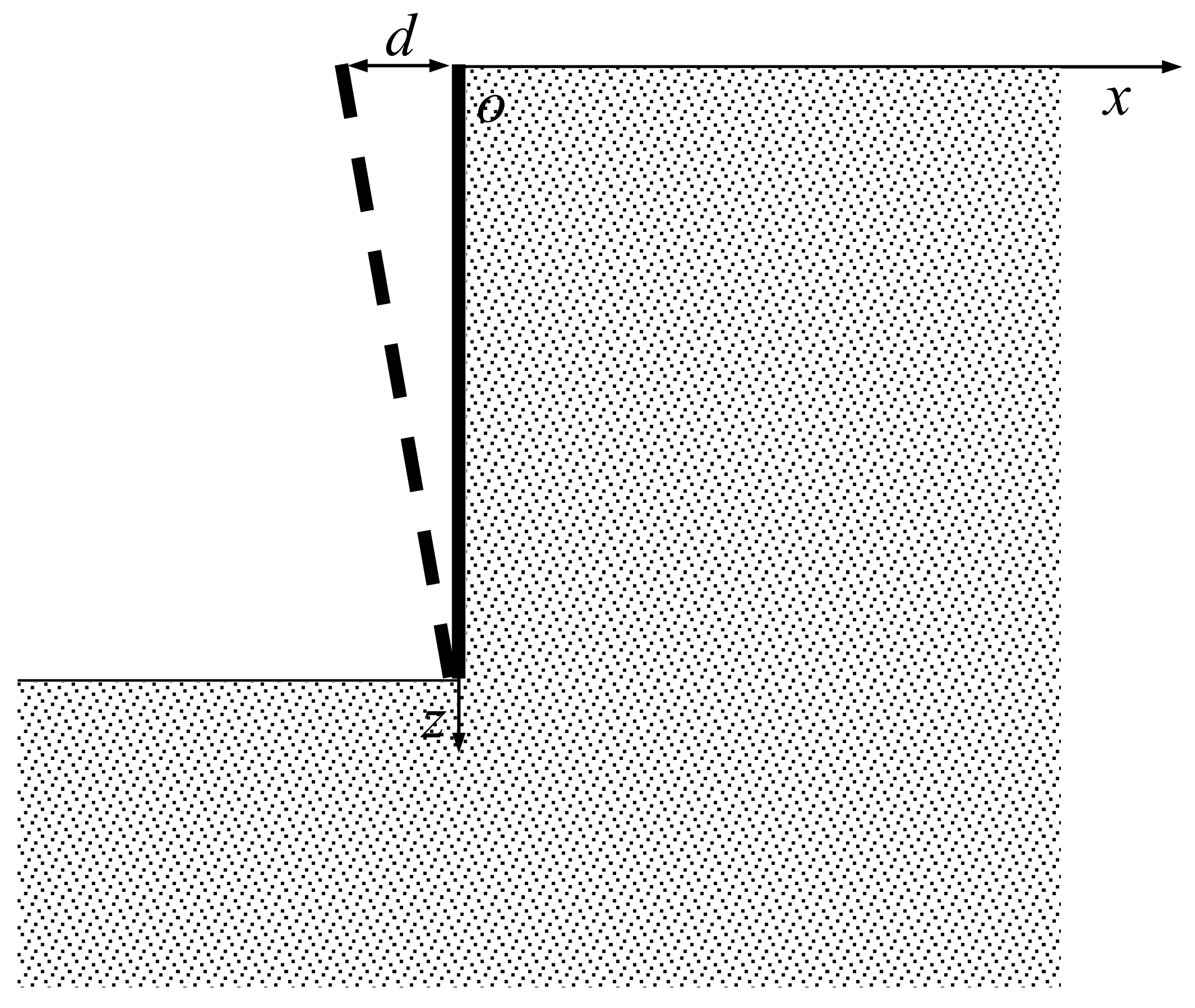

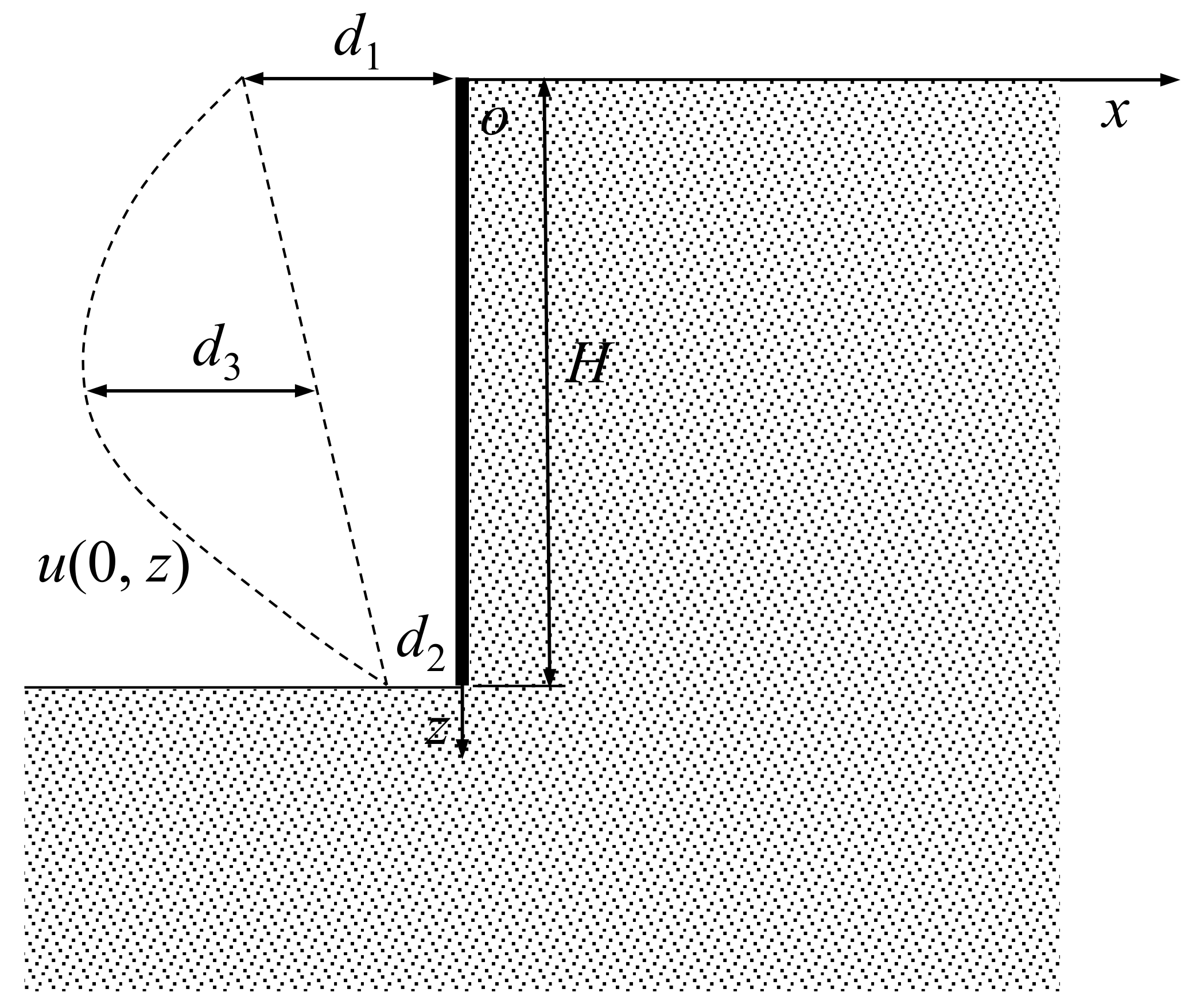
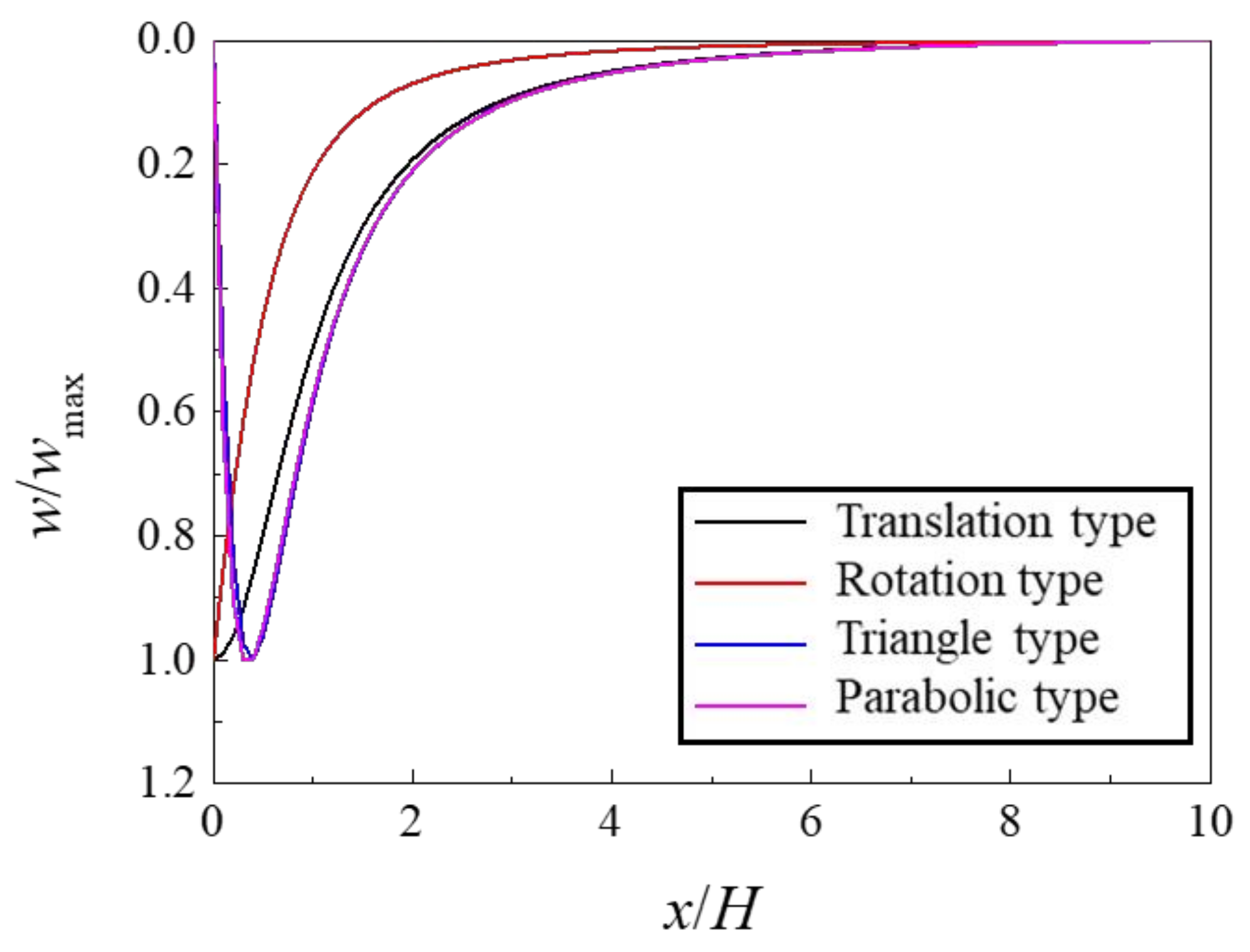
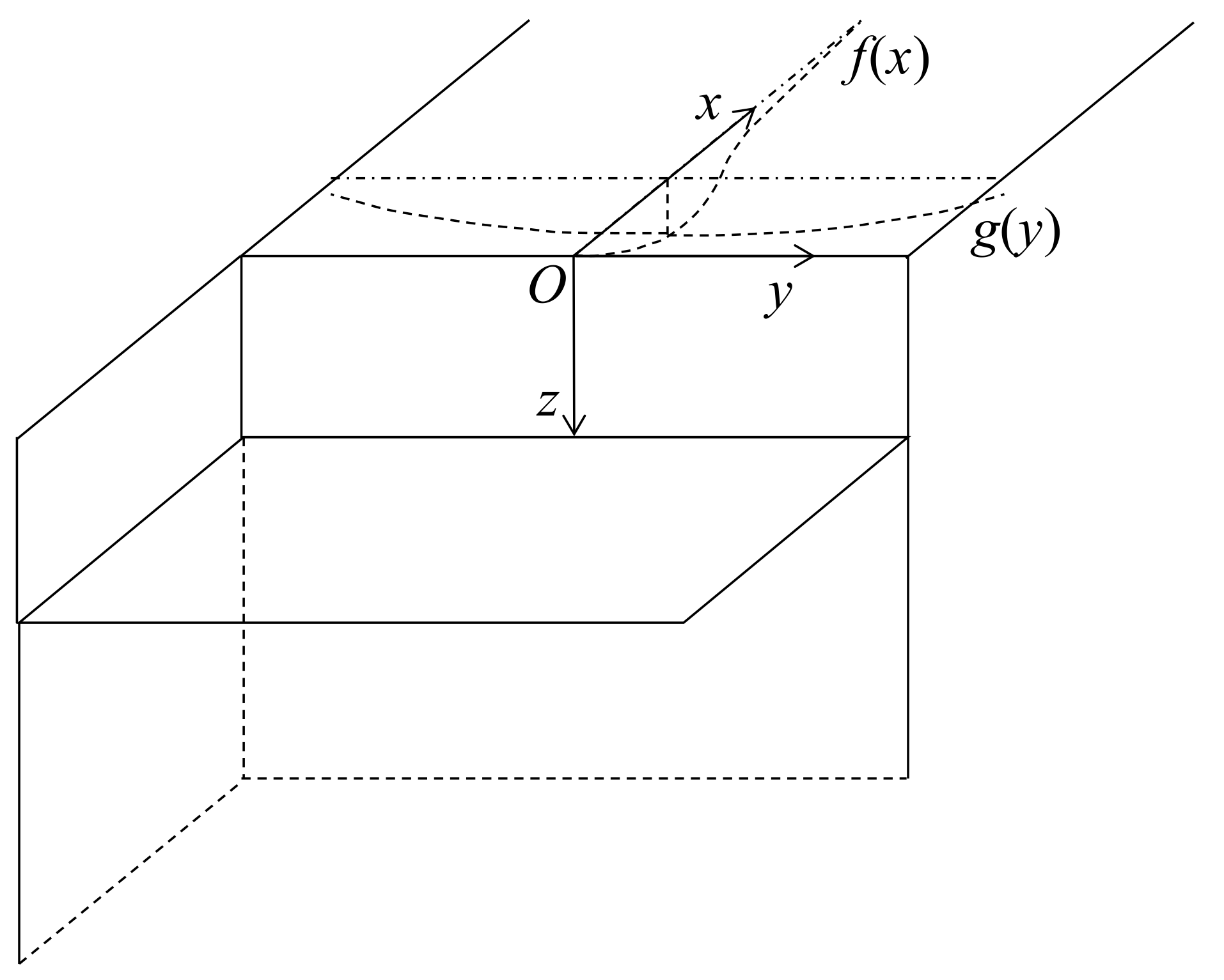




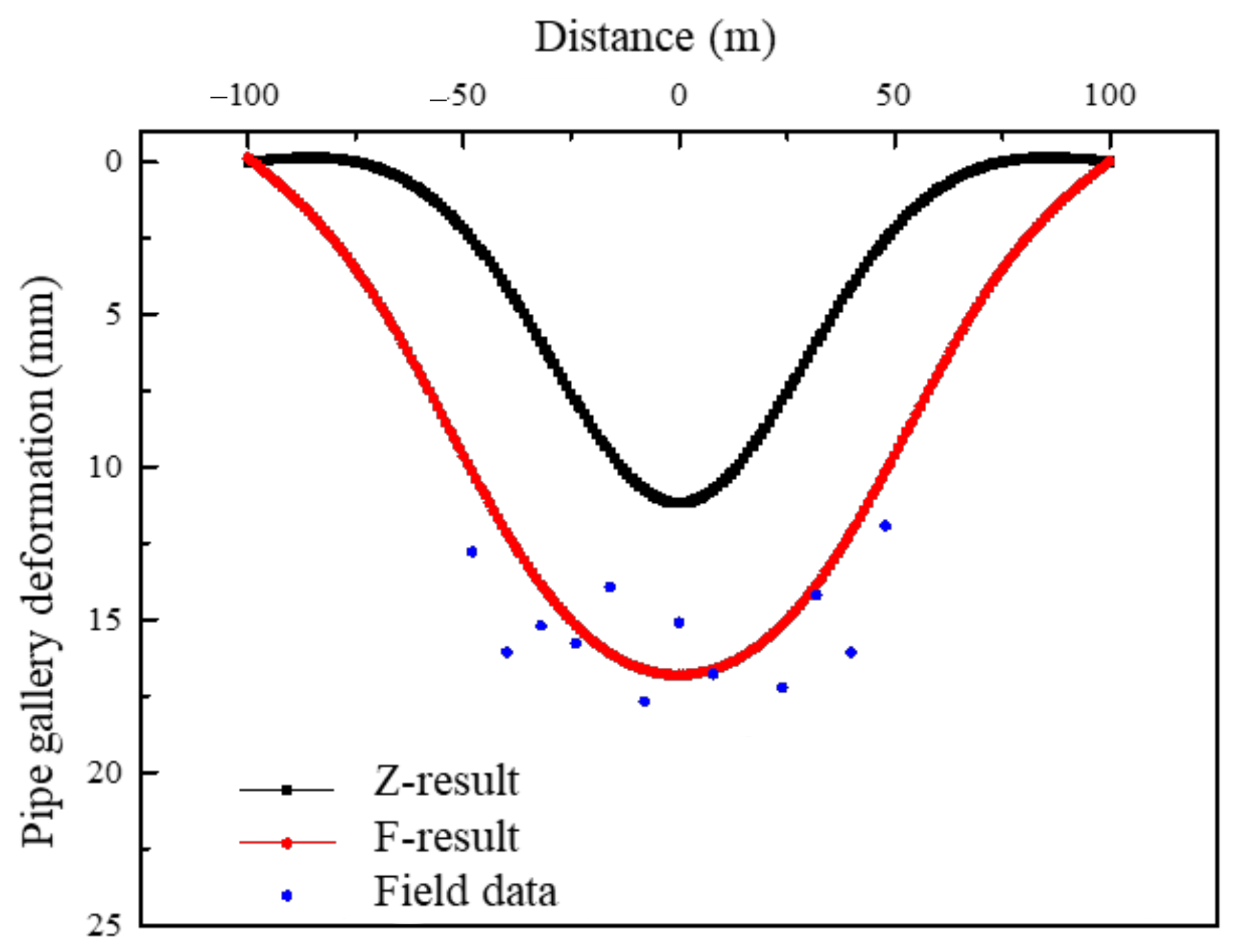
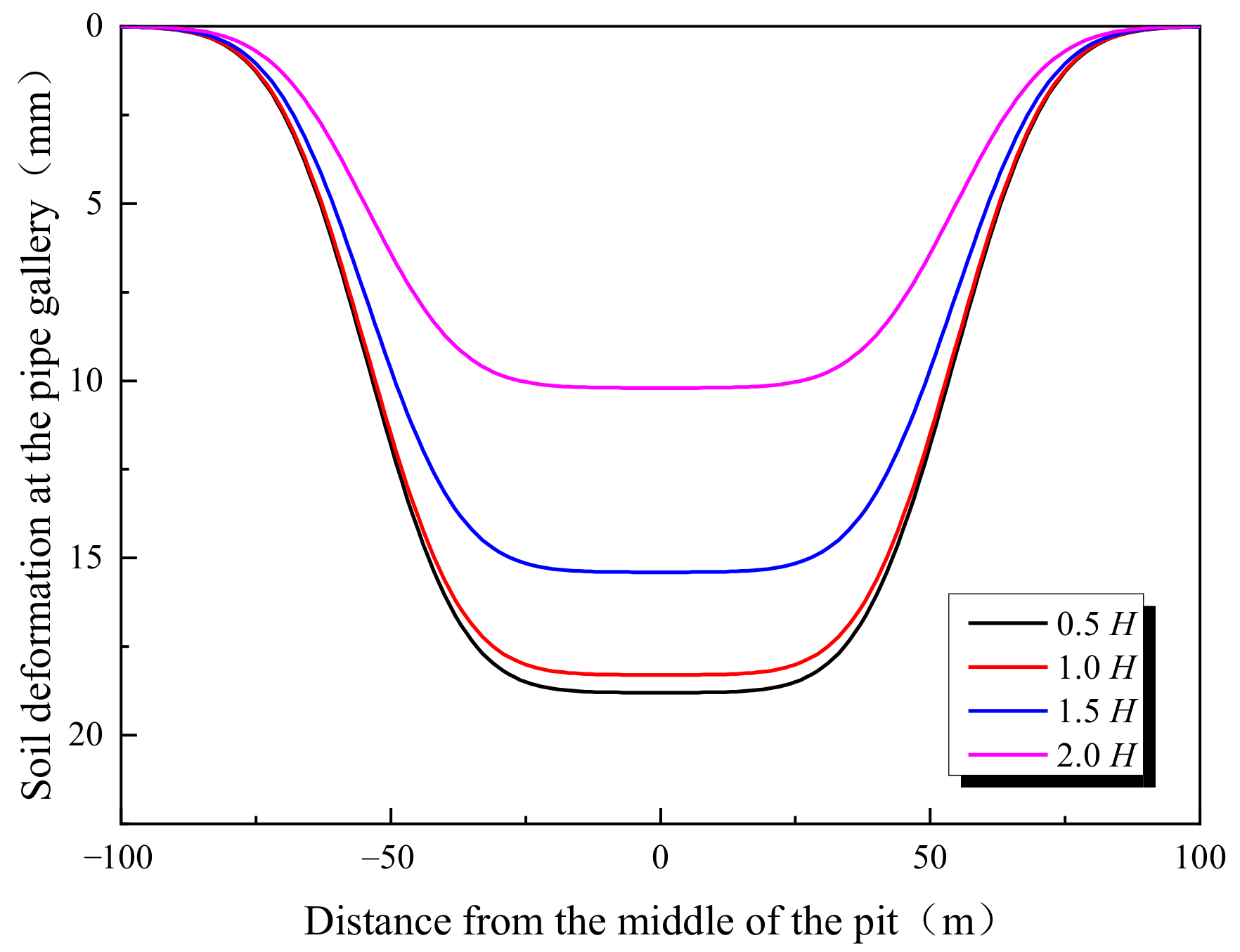
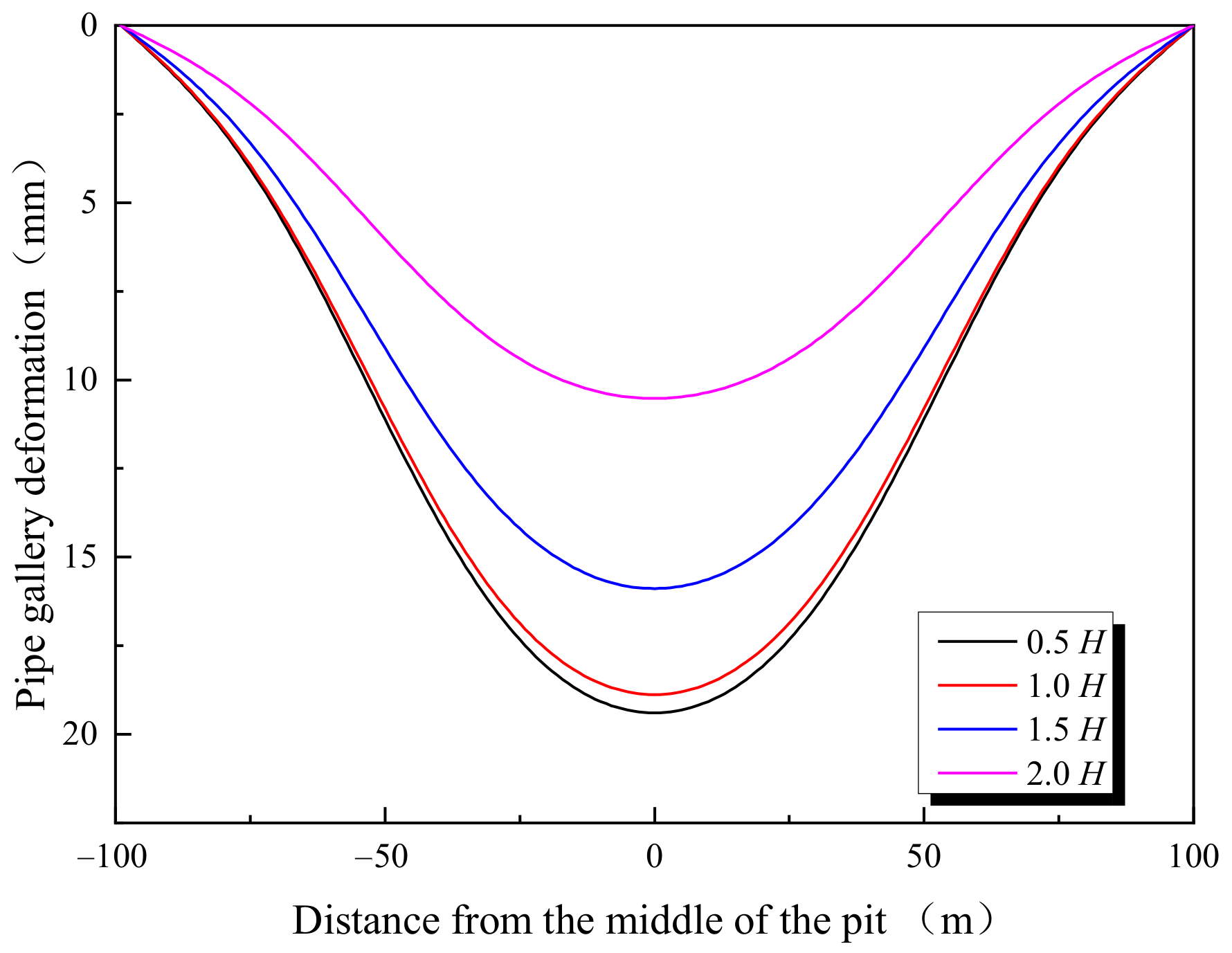

Disclaimer/Publisher’s Note: The statements, opinions and data contained in all publications are solely those of the individual author(s) and contributor(s) and not of MDPI and/or the editor(s). MDPI and/or the editor(s) disclaim responsibility for any injury to people or property resulting from any ideas, methods, instructions or products referred to in the content. |
© 2024 by the authors. Licensee MDPI, Basel, Switzerland. This article is an open access article distributed under the terms and conditions of the Creative Commons Attribution (CC BY) license (https://creativecommons.org/licenses/by/4.0/).
Share and Cite
Xiang, B.; Liu, Y.; Cui, J.; Yang, Z. Analytical Solution for the Deformation of Pipe Galleries Adjacent to Deep Excavation. Buildings 2024, 14, 1103. https://doi.org/10.3390/buildings14041103
Xiang B, Liu Y, Cui J, Yang Z. Analytical Solution for the Deformation of Pipe Galleries Adjacent to Deep Excavation. Buildings. 2024; 14(4):1103. https://doi.org/10.3390/buildings14041103
Chicago/Turabian StyleXiang, Binhui, Ying Liu, Jifei Cui, and Zhenkun Yang. 2024. "Analytical Solution for the Deformation of Pipe Galleries Adjacent to Deep Excavation" Buildings 14, no. 4: 1103. https://doi.org/10.3390/buildings14041103




